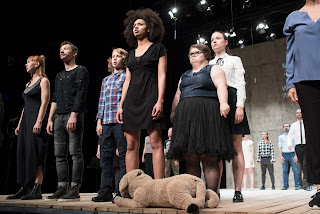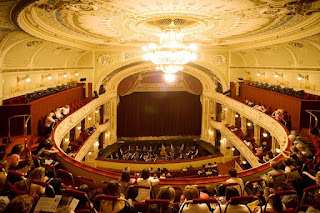Hymn to Love
= The 25 performers on the cast of Hymn to Love, produced by The Chorus of Women Foundation (Warsaw) and Polaski Theatre (Poznan) give us 50 minutes of extraordinary ensemble work in Hymn to Love. It’s the final play of a trilogy inspired by Brecht’s Mother Courage and her Children. This is strong political theatre, clear and convincing, never heavy-handed.
The show is written and directed by Marta Gornicka. She uses techniques from various sources - Judith Malina; Jerzy Grotowski; Bertolt Brecht - and binds them together with an inspired concept: the script presents nationalism from the point of view of the nationalists. The irony of the concept gives the production a valuable theatrical dimension; it involves us, the audience, in processing the message. Just so, the singing (which is excellent) and the chanting give the play distance. The cast also whisper, yell or bark as the occasion demands.
On a bare stage of handsome Pilsen’s New Theater, with its wooden plank floor and stoney back wall, the company present the fascism growing in Western culture. The cast is made up largely of woman and includes a disabled woman and a young boy. They often move as one, as when they’re marching, or they move individually as multiple manifestations of the same presence, with mechanical martial arts moves (the choreography is by Anna Godowska). Ms. Gornicka and her cast are articulate and commanding. “We are ordinary people,” they tell us - indeed, they look like us - and their anger grows as they congregate into an angry mob, radiating malice. It’s chilling to hear them whisper “The community is always innocent.” “Truth does not exist,” they proclaim, and the thought is as evident the USA as in Poland.
Ms. Gornicka stands in the audience directing the performers, making a statement about their relationship with us. The music sometimes echoes traditional and communist songs and, as I understand it, distorts them.
Largely, Hymn to Love’s statement is important and timely. But Ms. Gornicka seems to indict Christianity itself: we hear “Behold the Lamb of God Who takes away the sins of the world.” The piece ends with familiar liturgical music, maybe The Mass in C Minor (I’m not sure). What on earth does this mean?
review
Steve Capra
September 2019
_________________________________________________________________________________
_________________________________________________________________________________



Comments
Post a Comment